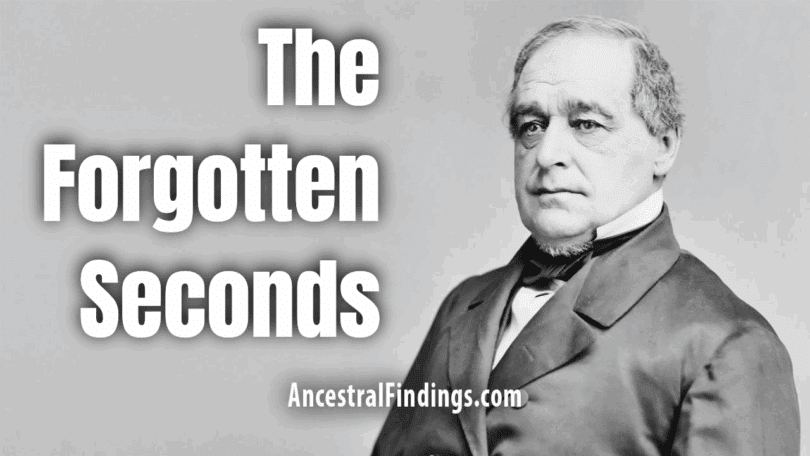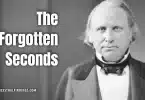As we continue our series, The Forgotten Seconds, we take a closer look at those vice presidents who, despite standing one heartbeat away from the highest office, never became president themselves. Today’s spotlight is on Hannibal Hamlin, Abraham Lincoln’s first vice president—a name that once carried national significance but has since faded from common memory. Hamlin’s life tells the story of New England grit, political courage, and quiet conviction in a turbulent era.
Deep Roots in Colonial New England
Hannibal Hamlin was born on August 27, 1809, in Paris Hill, a small community in what was then the state of Massachusetts but is now part of Maine. His family tree runs deep into the soil of early colonial America. On his father’s side, the Hamlins traced their American lineage to James Hamlin, who emigrated from England in the 1630s and settled in Barnstable on Cape Cod. James Hamlin’s descendants spread throughout New England, eventually giving rise to generations of civic-minded farmers, physicians, and ministers.
Hamlin’s father, Dr. Cyrus Hamlin, was a Harvard-educated physician and Revolutionary War veteran. He balanced his medical practice with farming and a position in the state legislature. His mother, Anna Livermore, descended from the Livermores of Watertown, Massachusetts, another established colonial family. Her father, Reverend Elijah Livermore, was a well-known minister. The influence of both families ensured Hannibal was brought up in a household where faith, education, and public service were considered natural parts of life.
Formative Years in the Maine Wilderness
Hannibal Hamlin grew up in rural Maine, where formal schooling was limited but learning was encouraged. He attended Hebron Academy but never enrolled in college. Instead, he studied law in a Bangor attorney’s office, as was customary at the time. He was admitted to the bar in 1833 and opened a law practice in Hampden, Maine.
His marriage to Sarah Jane Emery in 1833 connected him to another prominent Maine family. Sarah was the daughter of Stephen Emery, who later served as Maine’s attorney general. Together, Hannibal and Sarah had four children. Following her death in 1855, Hamlin married her half-sister, Ellen Vesta Emery, and had two more children.
The family’s private life remained rooted in Maine, where Hamlin maintained strong ties with his local community, even as his political responsibilities often called him away.
Entering the Political Arena
Hamlin began his political journey in the Maine House of Representatives in 1836. He quickly became known for his persuasive speaking style and strong character. In 1843, he was elected to the U.S. House of Representatives and then to the U.S. Senate in 1848 as a Democrat.
However, Hamlin was not content to go along with the party line. He became increasingly troubled by the Democratic Party’s support for the expansion of slavery. The passage of the Kansas-Nebraska Act in 1854—which allowed slavery to expand into new western territories—was a turning point for him. He left the Democratic Party and joined the newly formed Republican Party, bringing with him a sense of urgency and conviction that helped define the new political organization.
The Governor Who Didn’t Stay
In 1856, Hamlin was elected Governor of Maine as a Republican. But in a surprising move, he resigned the position after just one month to return to the U.S. Senate. While unusual, the resignation was strategic. Hamlin believed he could be more effective on the national stage as the Republican Party solidified its identity and purpose.
Chosen by Lincoln
When Abraham Lincoln was nominated as the Republican candidate for president in 1860, his team sought a running mate who would balance the ticket geographically and ideologically. Hannibal Hamlin fit the bill. He was a New Englander with national experience, and he had impeccable anti-slavery credentials.
Hamlin became Vice President in March 1861, just as the Civil War erupted. Despite the gravity of the national crisis, his role in the administration was limited. Like many vice presidents before him, he presided over the Senate but was largely excluded from the inner workings of Lincoln’s cabinet. Though the two men respected one another, they were not close collaborators.
Hamlin often pushed for stronger action against the Confederacy, including early enlistment of black soldiers in the Union Army. These ideas, once radical, would eventually become federal policy, but Hamlin did not always receive credit for advocating them.
A Political Shakeup in 1864
When Lincoln ran for re-election in 1864, he made the politically strategic decision to drop Hamlin from the ticket. In his place, Lincoln selected Andrew Johnson, a War Democrat from Tennessee, as a gesture of national unity. Johnson’s Southern roots were seen as a way to appeal to Unionists in border states and former Confederates who might be willing to accept the Union’s terms.
The decision stunned Hamlin. He had served faithfully and represented the principles of the Republican Party. Yet politics took precedence over loyalty. Had Hamlin remained on the ticket, he—not Johnson—would have become president following Lincoln’s assassination in April 1865. The course of Reconstruction might have looked very different under Hamlin’s leadership.
Return to Public Service
Despite this blow, Hamlin did not retire from politics. In 1869, he was re-elected to the U.S. Senate, where he served until 1881. By then, he was considered an elder statesman—well-respected and principled, though no longer at the center of national attention. He spoke out against corruption and supported civil rights for newly freed black Americans during the difficult Reconstruction period.
In 1881, Hamlin was appointed U.S. Minister to Spain by President James A. Garfield. However, he found diplomatic life dull and unfulfilling, returning home after only a year abroad.
Final Years and Death
Hamlin spent his final years in Bangor, Maine. He enjoyed playing cards, reading, and participating in the community. On July 4, 1891, while sitting at the Tarratine Club—his local gentleman’s club—Hamlin suddenly collapsed and died. He was 81 years old.
He is buried in Mount Hope Cemetery in Bangor, a city he had served for much of his life. Though his passing was noted in newspapers across the country, Hamlin’s name quickly faded from public memory.
Family Legacy
Hamlin’s children followed paths of public and military service. His son, Charles Hamlin, served in the Union Army and was present at Ford’s Theatre the night Lincoln was assassinated. Another son, Cyrus Hamlin, became a brigadier general and helped command black troops in the Civil War. The Hamlins remained prominent in Maine for generations, though none achieved the national stature of their father.
Pros and Cons of His Vice Presidency
Hamlin’s vice presidency was marked by integrity, but also by invisibility. He was firm in his opposition to slavery, loyal to the Republican cause, and committed to moral leadership. Yet he was not invited into Lincoln’s inner circle and had little influence over wartime policy.
He was ahead of his time in advocating for black troops and harsh penalties against traitors, but his unbending convictions may have made him less politically useful during a time when Lincoln was trying to hold a fragile Union together.
Had he been chosen again in 1864, history might remember him differently. Still, his unwavering principles were a defining feature of his political life.
Conclusion
Hannibal Hamlin may not have made it to the presidency, but his influence on the early Republican Party, his opposition to slavery, and his commitment to constitutional government left an imprint on the nation’s history. His story reminds us that not all meaningful leadership comes from the highest office. Sometimes, it’s the firm voice in the background—the one that holds the line while others waver—that shapes the moral arc of the country.
As we move forward in The Forgotten Seconds series, Hannibal Hamlin stands as a quiet yet strong example of character over convenience and conscience over ambition.







